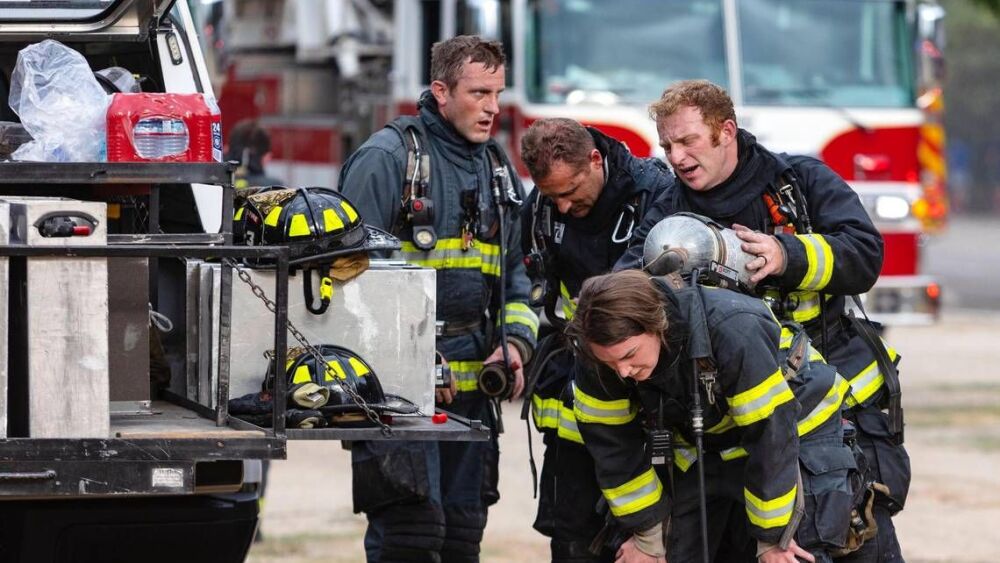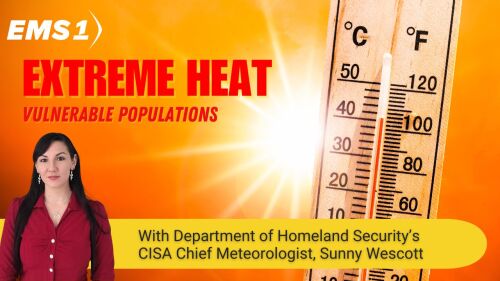Editor’s note: Firefighters and EMS personnel face significant risks of hyperthermia during intense operations, especially in high-heat environments. Prolonged exposure to extreme temperatures, combined with the insulating nature of protective gear, can lead to a spectrum of heat-related illnesses — from initial signs of heat exhaustion, to the critical condition of heat stroke. Recognizing and addressing these conditions promptly is essential to safeguard the health and effectiveness of emergency responders on the fireground.
This article, originally posted May 2017, has been updated to include updated information and additional resources.
Responders do not typically have control over environmental conditions, and care should be taken in extreme temperature circumstances. Direct sunlight and protective gear can increase the body’s core temperature. Conversely, immersion in water or exposure to windy conditions can significantly lower the body’s core temperature. The rehab sector should be configured to protect responders from both hot and cold conditions.
Many factors lead to heat stress, including environmental temperature, protective equipment, thermal considerations, underlying comorbidities and their treatments, humidity and acclimation. It is important that chiefs examine their SOPs and SOGs to ensure they are up to date with the current NFPA standards.
|More: Dr. Lori Moore-Merrell interviewed Chief Mary Cameli and Assistant Chief James Johnson from Mesa Fire and Medical Department, and Assistant Chief Tim Kreis from Phoenix Fire Department for an episode of The USFA podcast about how they are adapting to the extreme heat in the U.S. Listen here.
Basic prevention of dehydration with access to water should not be overlooked. A general rule of thumb is to ensure about 15.5 cups (3.7 liters) of fluids a day for men and about 11.5 cups (2.7 liters) of fluids a day for women, depending on environmental factors. Alternating with sports drinks for extended operations is also useful. Responders can take advantage of hydration body-worn packs while in operation and should be hydrated orally during rehabilitation.
Despite best efforts, during extended operations or extreme exertion in difficult environments, heat injuries and illnesses can occur. Heat illnesses can range from minor issues of miliaria rubra (heat rash) and heat cramps to heat stroke, a life-threatening illness. Heat illnesses usually occur on a spectrum, and minor illnesses, if not addressed, can progressively worsen.
Heat cramps
Heat cramps typically occur in hot environments when the responder is producing large volumes of sweat. They consist of brief involuntary, intermittent cramps in muscle groups already fatigued by exertion.
Three factors contribute to heat cramps: salt depletion, dehydration and muscle fatigue [1]. Typically they are not dangerous and rarely result in rhabdomyolysis or muscle breakdown.
Treatment should include systemic cooling, replacement of lost water and electrolytes, and rest. Oral hydration with fluids such as sports drinks serves to replace water as well as electrolytes that are typically lost with sweating.
While electrolyte replacement is important in the management of heat cramps, salt tablets are generally not recommended. Salt tablets are gastric irritants and have been shown to delay gastric emptying, which can lead to nausea and vomiting, worsening dehydration [2].
When the heat cramps resolve, the responder often can return to active duty. Repeated cramping can signal more significant dehydration and need for removal from operational duties. If cramps do not resolve with the above maneuvers or the cause of the cramping is in doubt, the responder should be transported to a hospital for further evaluation.
Heat exhaustion
As a responder’s core temperature continues to rise, morbidity progresses along the heat illness spectrum to heat exhaustion and heat stroke. Heat exhaustion is the inability to continue exercise, along with any combination of heavy sweating, dehydration, sodium loss and energy depletion [3].
Symptoms of heat exhaustion can be broad and nonspecific. Common symptoms include headache, fatigue, nausea, dizziness and pre syncope. A physical exam may reveal profuse diaphoresis, tachycardia, tachypnea, normal mental status with temperature elevation up to 104° F.
Treatment for heat exhaustion includes removal from the environment, continuous monitoring (as progression to heat stroke can rapidly occur), active cooling and oral rehydration. Cooling the responder’s skin with tepid water will avoid the vasoconstriction produced by ice cold water, which could be counter-productive by inhibiting heat exchange at the surface. Icy water could induce uncomfortable shivering as well.
Heat stroke
Heat stroke is classically defined as a core temperature of greater than 104° F or signs of end organ dysfunction. Typically the body’s intrinsic regulatory mechanisms are overwhelmed and the central nervous system is affected, manifesting as alterations of mental status.
Altered mental status is the hallmark of heat stroke and also exists on a spectrum from behavior changes early on to syncope and seizures. As the body’s intrinsic regulatory mechanisms fail, the skin changes from diaphoretic to hot and dry. Keep in mind that the responder may have heat stroke even if he or she is still sweating.
Hypoglycemia may occur as the result of increased glucose metabolism and hepatic damage, resulting in impaired gluconeogenesis [4]. As with all responders with altered mental status, point-of-care blood sugar should be assessed and treatment based on local protocols should be initiated.
Death occurs at a core body temperature of 107° or above.
Heat stroke cooling options
In addition to the above treatments for heat exhaustion, lowering the body’s temperature as rapidly as possible is the most important objective in the treatment of a suspected heat stroke patient. Some reports indicate that aggressive, active cooling of heat stroke patients can reduce mortality rates from 50% without active cooling to 5% (USFA).
Most recent evidence recommends cooling on scene prior to transport to minimize hyperthermia time. Cold water immersion is recommended with enough ice to maintain a water temperature of 10°C/50°F.
IV access should be obtained and the patient’s hemodynamic status supported with IV fluids. Consider airway control depending on the patient’s status during transport to definitive care.
Cooling a patient with heat stroke should be continued until the body’s core temperature reaches 102° F. If heat stroke cannot be excluded, cooling should be initiated.
Antipyretic medications such as acetaminophen and ibuprofen have no role in the treatment of environmental hyperthermia and should not be administered.
Rehab planning and protocols
Remember to incorporate environmental concerns, including heat emergencies, into your rehab plans and medical threat assessments. Know that responders are at risk for heat emergencies even when ambient temperatures are not extreme, as exertion and gear can contribute significantly to core body temperature.
Routine prevention of dehydration should be employed, and early signs of heat injury, such as heat cramps, should not be ignored as they can portend a progression to life-threatening heat stroke.
Finally, do not get tunnel vision, as altered mental status has a wide differential. If something doesn’t add up, address life threats, transport the patient to an emergency department and don’t hesitate to contact medical control.
With a healthy balance of prevention and vigilance, most severe heat injuries can be avoided, and you will be prepared for any that are not.
Use the revised NFPA 1584 to direct your on-scene rehab protocols and activities.
References
- Campbell JE, Heiskell LE, Smith J, Wipfler EJ. Tactical Medicine Essentials, Sudbury, MA Jones & Bartlett, 2012
- Brake DJ, Bates GP. Fluid losses and hydration status of industrial workers under thermal stress working extended shifts. J Occup Environ Med. 60:90 2003
- Brinkley H.M, Bechett J., Casa D.J., Kleiner D.M., Plummer P.E. National Athletic Trainers Association Position Statement on Exertional Heat Illnesses, Journal of Athletic Training. 2002L 37(3) 329-343
- Marx JA, Hockberger RS, Walls RM, et al. Rosen’s Emergency Medicine Concepts and Clinical Procedures, Philadelphia, PA; Mosby/Elsevier, 2010
- Casa, DJ, Armstrong LE, Kenny GP, O’Connor FG, Huggins RA. Exertional Heat Stroke: New Concepts Regarding Cause and Care, 2012





